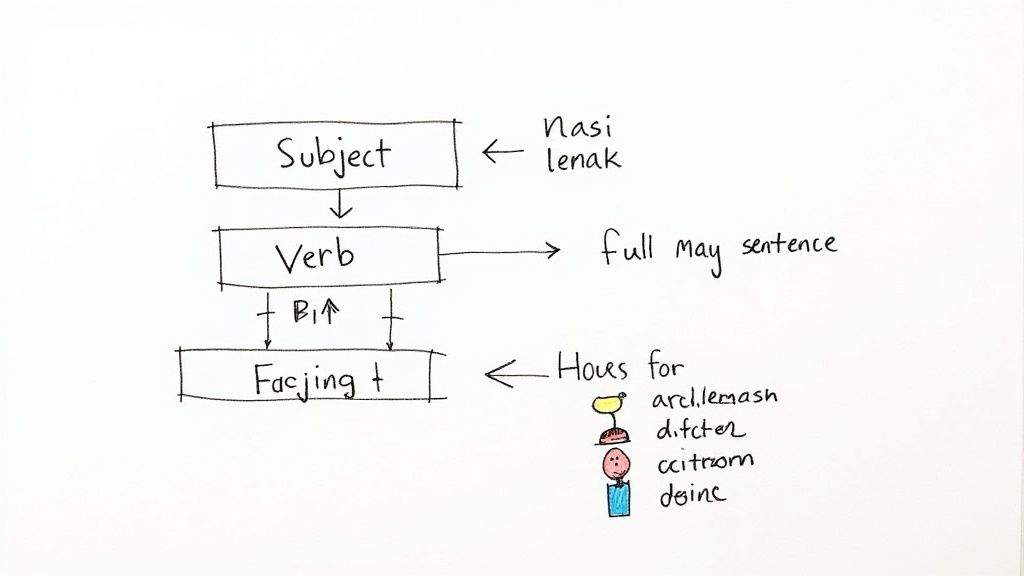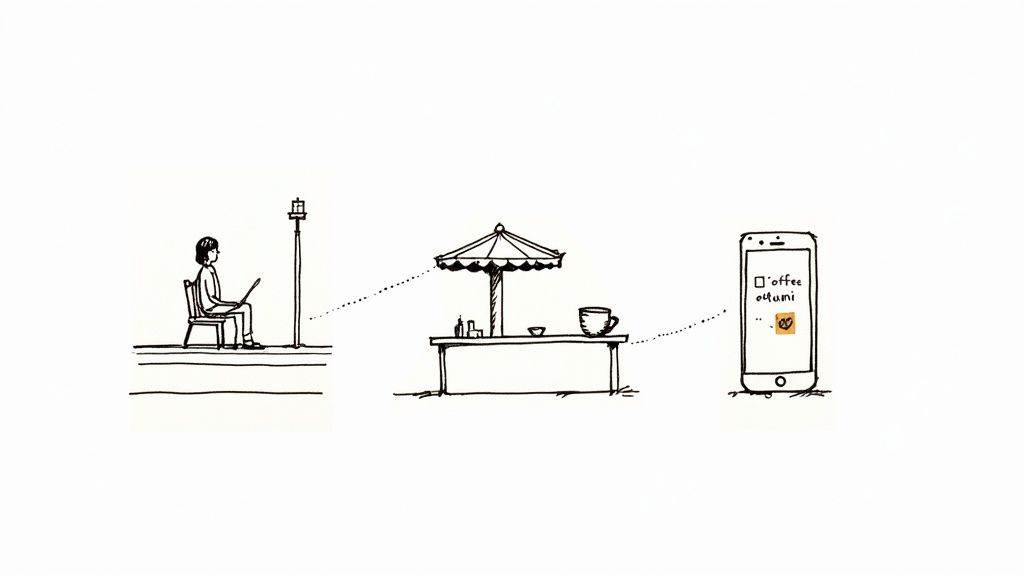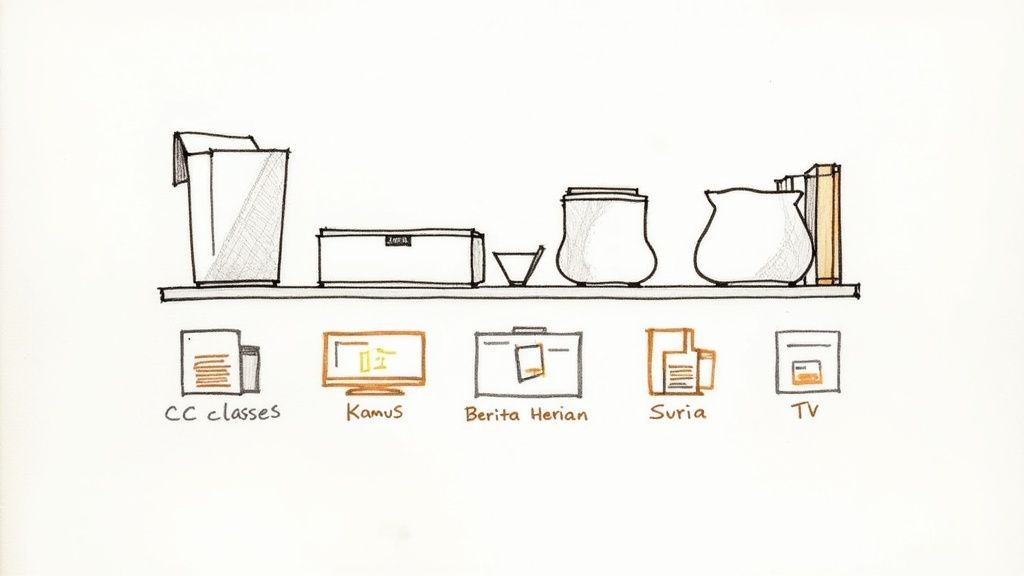A Practical Guide to Learning Bahasa Melayu
Learning Bahasa Melayu is a fantastic journey, one that connects you to the heart of Singapore's rich heritage. And here's the best part: it's far more approachable than you might imagine. The language uses a phonetic alphabet and has wonderfully straightforward grammar, meaning you can start stringing together basic sentences and communicating surprisingly quickly.
Your Path to Speaking Malay in Singapore
If the thought of complex grammar rules has put you off learning a new language, Bahasa Melayu is a refreshing change of pace. It mostly does away with the tricky gendered nouns and complicated verb tenses that often trip up English speakers. Instead, its structure is logical, built on core root words that are modified with simple prefixes and suffixes.
This simplicity makes learning Malay more than just a language lesson; it’s a direct cultural bridge. It opens up a deeper connection with one of Singapore's four official languages and its incredibly vibrant community.
A Welcoming Language Structure
One of the biggest wins for any new learner is the language's phonetic nature. The Malay alphabet uses the same Roman letters as English, and each letter almost always makes the same sound. This consistency is a huge advantage—it means you can confidently pronounce new words just by reading them.
The real beauty of learning Malay lies in its accessibility. Once you get the hang of the basic sounds and sentence structure, you can start combining words to express yourself in meaningful ways almost right away.
Plus, the sentence construction often follows a simple Subject-Verb-Object pattern, just like English. For example, "Saya minum air" translates word-for-word to "I drink water." This familiar format is a great confidence booster right from the start.
Connecting with Singaporean Culture
Malay holds a special place in Singapore's history. While English is the main language of business and administration, Malay remains a cornerstone of our national identity. You can see it in our national anthem, hear it in military commands, and taste it in our rich culinary traditions.
Even though it was once the common language of the region, only 16.4% of Singaporeans aged 15 and above are literate in Malay today. What's fascinating is that nearly a quarter of them are non-Malays, which points to a growing cross-cultural interest in reconnecting with this heritage language.
Embarking on this journey also does wonders for your mental agility. Learning a language is a workout for your brain, and doing some cognitive flexibility exercises can help prepare your mind for the new patterns you'll be learning. This guide is designed to give you the tools and mindset to start speaking with confidence and truly connect with the soul of Singaporean culture.
Mastering Pronunciation and Essential Greetings
When you're jumping into a new language, the very first thing to tackle is how it sounds. For anyone learning Bahasa Melayu, this is where you get a huge confidence boost right from the start. Why? Because the language is beautifully phonetic.
This means words are pronounced exactly as they're spelt using the familiar Roman alphabet. You can say goodbye to the guesswork that makes learning other languages so tricky. There are no silent letters or bizarre spelling rules to memorise here. Once you nail the sound for each letter, you can look at almost any Malay word and pronounce it correctly.
Cracking the Vowel Sounds
The five vowels are the absolute foundation of spoken Malay. Get these right, and your speech will immediately sound clearer and more authentic. Unlike English, where a single vowel can have multiple sounds, each Malay vowel generally sticks to just one.
Let's break them down with some simple English comparisons:
- A is always like the 'a' in "father".
- E has two main sounds. The most common is a short 'e' like in "bed" (this is called e pepet). Less frequently, it sounds like the 'a' in "cake" (e taling). Don't worry, context almost always makes it clear which one to use.
- I is a crisp 'ee' sound, just like in "see".
- O sounds like the 'o' in "go".
- U is always a long 'oo' sound, like in "moon".
Practising these sounds can be fun. In fact, if you want to warm up your mouth muscles for any language, you could even try our guide on tricky tongue twisters in English to get your articulation sharp.
From Sounds to Speaking
Once you've got a handle on the basic sounds, it's time to start talking! The best way in is with essential greetings. These aren't just polite words; they're your ticket into daily conversations and a sign of respect for the local culture.
A simple "Selamat pagi" to your neighbour or "Terima kasih" to a hawker uncle doesn't just get you through a transaction—it builds a connection. It shows you're making an effort, and that is always appreciated.
Think about it in a real-world scenario. You're at a kopitiam (a local coffee shop). Instead of just pointing, you can start small. A polite "Selamat pagi" (Good morning) makes a great first impression. After you get your kopi, a warm "Terima kasih" (Thank you) feels natural and shows gratitude.
Here are the core phrases you'll use all the time:
- Selamat pagi (Good morning) – Use this until about 11 AM.
- Selamat tengah hari (Good afternoon) – Typically from noon until around 2 PM.
- Selamat petang (Good evening) – From the late afternoon until the sun goes down.
- Apa khabar? (How are you?) – A friendly, all-purpose greeting.
- Khabar baik (I'm fine) – The standard, positive reply.
- Sama-sama (You're welcome) – The polite response after someone thanks you.
These phrases are your passport to everyday interactions, turning ordinary moments into fantastic opportunities to practise.
Building Your First Malay Sentences
Alright, you've got the sounds and basic greetings down. Now for the fun part: actually putting words together to say what you mean. The best news for anyone learning Bahasa Melayu is that its core structure is surprisingly straightforward, especially if you're coming from English.
Forget spending weeks memorising complicated verb tables or figuring out grammatical genders. Malay often uses the same Subject-Verb-Object (SVO) pattern we do. This simple, logical flow means you can start stringing together useful ideas way faster than you might think.
The Power of Core Vocabulary
Before you can build sentences, you need the bricks. A killer strategy is to laser-focus on the 100 most common words. These are the words that pop up constantly in everyday chats around Singapore, covering the essential things, actions, and people you'll bump into.
Think about what you actually need to say.
- Nouns (Kata Nama): nasi (rice), air (water), rumah (house), kawan (friend)
- Verbs (Kata Kerja): makan (eat), minum (drink), pergi (go), mahu (want)
- Pronouns (Kata Ganti Nama): saya (I), awak (you), dia (he/she)
Getting comfortable with just these few words gives you the tools to express basic needs and observations. Trust me, that first successful interaction is a massive confidence boost.
Your First Sentences in Action
Let’s put that SVO structure to work with our new vocabulary. The beauty of it is that for many simple sentences, it feels almost like a direct word-for-word translation. It’s more like solving a simple puzzle than tackling a huge grammatical challenge.
Picture yourself at a hawker centre.
- Subject: Saya (I)
- Verb: mahu (want)
- Object: makan nasi lemak (to eat nasi lemak)
Just line them up: "Saya mahu makan nasi lemak." That's it. It’s a complete, grammatically sound sentence that anyone will understand. This direct method works for tons of common phrases, letting you communicate effectively right from the get-go.
The key takeaway here is to embrace the simplicity. Don't try to overcomplicate things at the start. Stick to the SVO pattern with your core vocabulary, and you'll build conversational confidence much more quickly and naturally.
A Gentle Introduction to Imbuhan
As you get more comfortable, you'll start noticing a key feature of Bahasa Melayu: imbuhan, which are essentially prefixes and suffixes. These little additions latch onto a root word to tweak its meaning or change its role in a sentence. It might sound a bit technical, but the idea is actually quite intuitive.
Let's take the root word ajar, which means "teach."
- Stick the prefix bel- on the front, and you get belajar, meaning "to learn."
- Swap that for the prefix peng-, and you have pengajar, which means "teacher."
Don't feel like you need to memorise all the imbuhan at once. That's not the goal. For now, just start noticing them. When you learn a new word, see if you can spot a pattern. You’ll soon see that many action verbs start with me-, or that nouns for people often begin with pe-. This kind of gentle awareness is way more useful than cramming rules from a textbook. Over time, understanding these affixes will become second nature and will unlock a much richer vocabulary.
Integrating Malay into Your Daily Singapore Life
Real language fluency isn't something you can just get from a classroom. It’s forged in the small, everyday moments. The key to learning Bahasa Melayu is to weave it into your daily routine here in Singapore, making practice feel less like a chore and more like a natural part of your day.
This is where you'll see the most progress. Forget just memorising vocabulary lists; it's time to start living the language. The city itself becomes your best teacher, packed with chances to listen, read, and speak.
Turn Your Daily Commute into a Lesson
That daily trip on the MRT or bus? It's a golden opportunity for some sneaky, immersive learning. It's dedicated time you can use to tune your ear to the rhythms and sounds of Malay. Instead of just scrolling through social media, switch things up.
Pop in your earphones and tune into a local Malay radio station like Warna 94.2FM. You'll get to hear native speakers chatting, listen to news reports, and enjoy popular music. It's a fantastic way to get a feel for the natural flow and intonation of the language.
Another simple trick is to just look around you. Public transport signs, safety announcements, and advertisements are almost always multilingual. Take a moment to read the Malay text and see if you can connect it with the English version. This kind of low-effort, constant exposure is brilliant for reinforcing vocabulary in a real-world context.
Everyday Interactions at Hawker Centres and Markets
The vibrant hawker centres and wet markets scattered across Singapore are perfect practice grounds. These are friendly, low-pressure environments where you can try out simple phrases and build up your confidence one interaction at a time.
Next time you’re ordering your morning kopi, give it a go in Malay.
- Start with a simple "Selamat pagi, pakcik/makcik" (Good morning, uncle/auntie).
- Then, place your order: "Saya mahu kopi o satu" (I want one black coffee).
- Finish with a warm "Terima kasih" (Thank you).
These little exchanges make a huge difference. They take the language off the page and bring it into the real world, creating memorable learning experiences that really stick.
Remember, the goal isn't perfection; it's participation. Most locals will be genuinely delighted and encouraging when they hear you making an effort to speak their language. Every attempt, no matter how small, is a solid step forward.
Using Digital Tools for Local Practice
While self-study is important, nothing beats actually speaking with other people. Thankfully, modern tools can help you connect with practice partners right here in Singapore. Finding someone for a casual conversation is a fantastic way to improve your speaking. A good place to start is to look into a language exchange in Singapore where you can meet native speakers.
You should also dive into digital Malay content made by Singaporeans. Follow local Malay influencers on Instagram or TikTok, watch shows on the Suria channel, or read articles from Berita Harian online. This exposes you to colloquialisms and the modern, everyday version of the language spoken here.
This daily digital immersion is more important than ever. While 97% of Malays aged 15–24 are bilingual, there's a growing concern that true fluency is declining, making active practice vital. By using the language, you’re not just learning—you’re helping to keep it vibrant.
Your Curated List of Singapore Learning Resources
Alright, let's talk about tools. Having the right resources makes all the difference when you're learning Bahasa Melayu, and thankfully, Singapore has plenty to offer. While self-study is great, stepping into a structured class can really accelerate your progress. Nothing beats having an expert to guide you and a clear path to follow.
For a gentle start, check out the courses at your local Community Centre (CC). They often run affordable introductory Malay classes that are perfect for getting your feet wet in a relaxed, friendly setting. You'll cover the basics—core grammar and essential conversational phrases—which is exactly what you need at the beginning.
If you’re ready for something more serious, a dedicated language school is the way to go. These places offer a much deeper dive with structured levels from beginner all the way to advanced. To help you navigate your options, have a look at our guide on choosing a language school in Singapore; it’s got some great tips for finding a fit that matches your goals.
The Self-Study Essentials
Even if you join a class, what you do on your own time is just as important. Your personal toolkit will become your daily companion.
First things first: get a good dictionary. The Kamus Dewan is the gold standard for Bahasa Melayu. I can't stress enough how useful it is for digging into word meanings and seeing how they’re used in real sentences. It’s a must-have.
For a local touch, keep the Malay Language Council of Singapore website bookmarked. It's packed with articles and cultural info that place the language firmly in a Singaporean context. This is crucial for sounding natural and understanding local nuances.
Don’t just learn the words; learn the culture they come from. Engaging with local media connects you to the heartbeat of the language as it’s spoken today, making your skills relevant and authentic.
Get Immersed: Real-World Media Practice
This is where the magic happens. Immersion brings the language to life. When you start consuming media made for native speakers, you train your ear, pick up on slang, and keep your motivation high. Singapore makes this incredibly easy.
- Your Daily Dose of News: Make it a habit to skim Berita Harian, Singapore's main Malay newspaper. Just reading headlines and short articles is a fantastic way to pick up vocabulary on current topics.
- Sharpen Your Listening Skills: Flip on Suria, our local Malay TV channel. Watching dramas and news broadcasts exposes you to different speaking speeds and accents, which does wonders for your comprehension.
- Learn with Videos: Online videos are a goldmine for practice. A handy trick is to turn the audio into a transcript for you to study. A good YouTube video to text converter can be a game-changer for creating your own learning materials from channels you enjoy.
Comparing Bahasa Melayu Learning Resources
With so many options, how do you decide what’s right for you? Different resources serve different needs. This table breaks down the common choices to help you find the best fit for your learning style and budget.
| Resource Type | Best For | Pros | Cons |
|---|---|---|---|
| Community Centres | Casual beginners and budget-conscious learners. | Very affordable, relaxed environment, convenient locations. | Limited depth, may not progress to advanced levels. |
| Language Schools | Serious learners seeking a structured curriculum. | Expert teachers, clear progression, immersive setting. | More expensive, requires a consistent time commitment. |
| Dictionaries & Apps | Quick look-ups and on-the-go vocabulary building. | Instant access, often free or low-cost, portable. | Lacks conversational context, can't teach grammar rules. |
| Local Media (TV/News) | Intermediate learners aiming for fluency and cultural context. | Authentic language use, exposure to slang and accents. | Can be overwhelming for absolute beginners, lacks structure. |
Ultimately, the best strategy is a mix-and-match approach. Combine a structured course from a CC or language school with your own self-study using dictionaries, apps, and plenty of local media. This well-rounded method ensures you’re not just memorising phrases but truly internalising the language in a way that feels natural and connected to daily life in Singapore.
Got Questions About Learning Bahasa Melayu?
Starting out with a new language always brings up a few questions. That's completely normal. Getting some clear, honest answers can really smooth out the learning curve and keep you fired up. So, let’s get into some of the things people often wonder about when they start learning Malay.
How Long Until I Can Actually Hold a Conversation?
This is the big one, isn't it? Everyone learns at their own pace, but if you're consistent, you could find yourself having basic conversations in just three to six months. We’re talking about the essentials here – greeting people, ordering your kopi just the way you like it, and asking for directions without getting lost.
Getting properly fluent is a longer game, for sure. But here's a tip from experience: it's not about marathon study sessions. A little bit every day goes a long way. Seriously, 15-20 minutes of focused practice daily will build a much more solid foundation than a long, cramming session once a week. Consistency is key.
Aren't Bahasa Melayu and Bahasa Indonesia the Same Thing?
It’s a common misconception, but no, they aren't identical. While they come from the same language family and speakers can often understand each other, think of it like the difference between British and American English – but with even more significant distinctions. You'll find plenty of differences in vocabulary, spelling, and pronunciation.
For anyone learning in Singapore or Malaysia, you absolutely need to focus on Bahasa Melayu. Dropping an Indonesian word into a conversation here could get you some funny looks or just plain confuse people. Stick to local resources to make sure you're learning the right lingo for the right place.
A heads-up for English speakers: The grammar is surprisingly straightforward. The real challenge often lies in mastering 'imbuhan' – those little prefixes and suffixes that can completely change a word's meaning. Get those down, and you'll sound much more natural.
Do I Really Need to Learn the Jawi Script?
For everyday use? Not at all. Modern Bahasa Melayu uses the Roman alphabet, which we call Rumi. This is the standard you'll see everywhere in Singapore and Malaysia – on road signs, in newspapers, on websites, everywhere.
The Jawi script, which is derived from Arabic, is mostly used for religious texts or in very traditional and ceremonial contexts today. You might spot it on historical buildings, but you don't need it to chat with people or get around. Your time is much better spent mastering Rumi.
At Spanish Council Singapore, we believe learning a new language is one of the best ways to connect with another culture. While Spanish is our passion, we love supporting anyone on their linguistic journey. If you're looking to start your own adventure, check out our small-group classes and personalized tutoring.
















